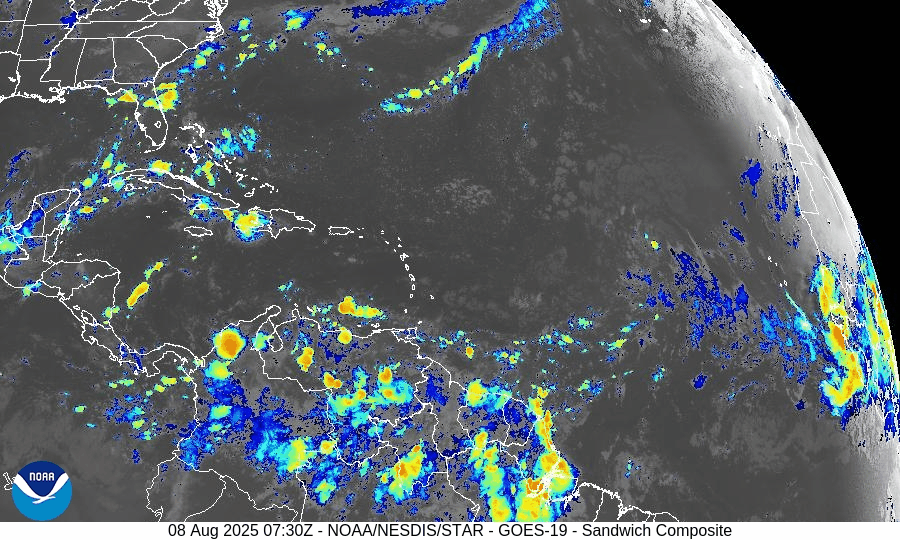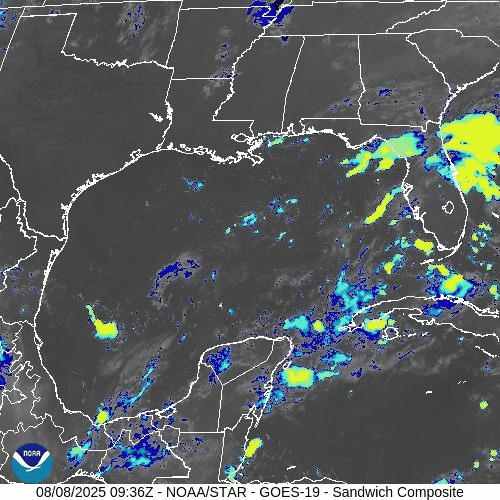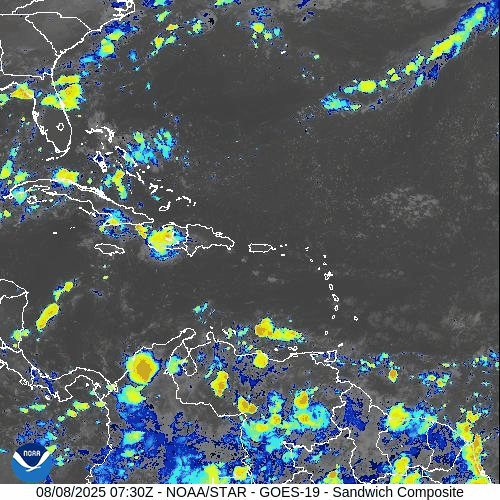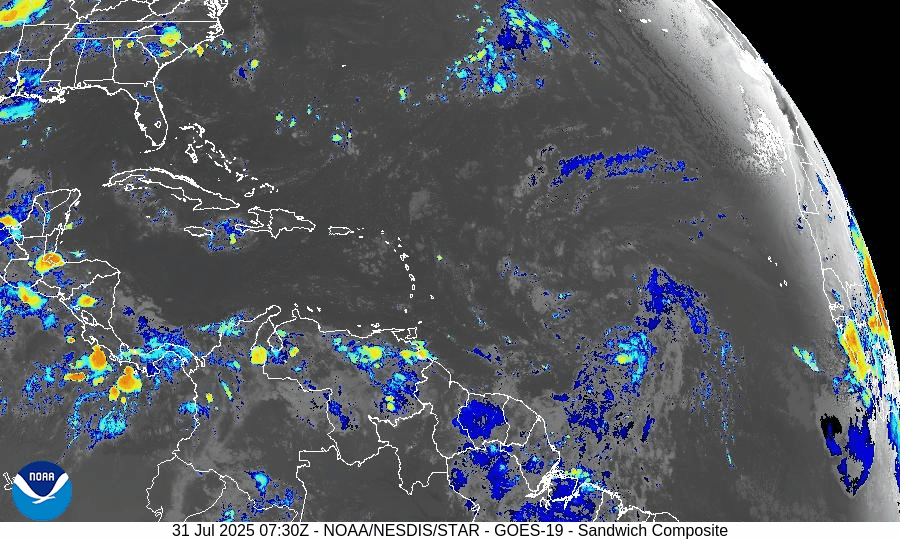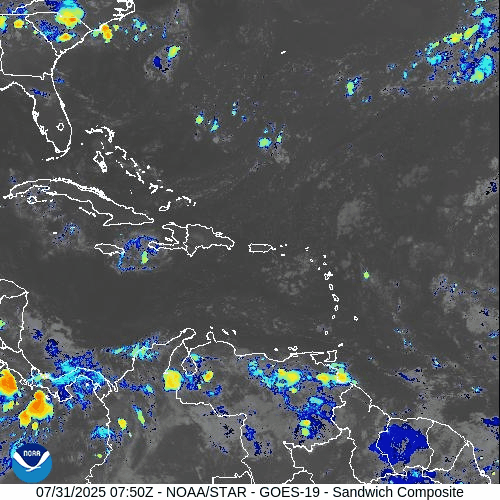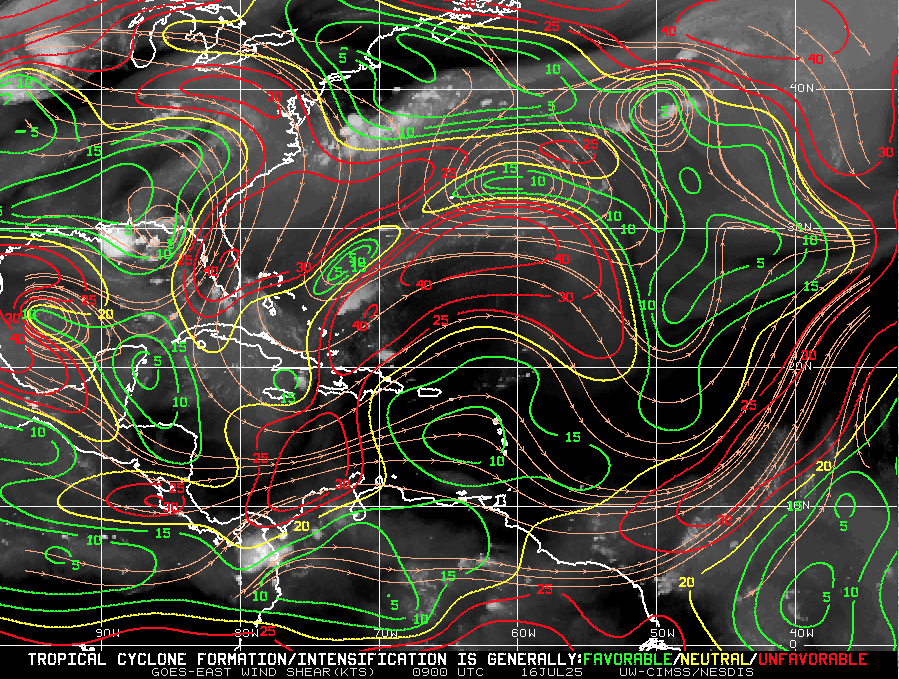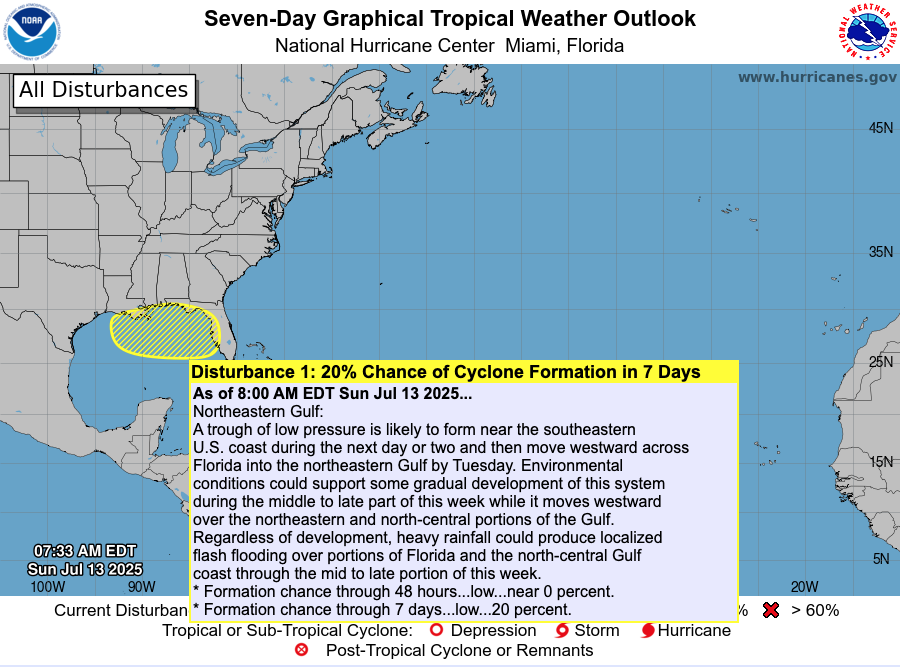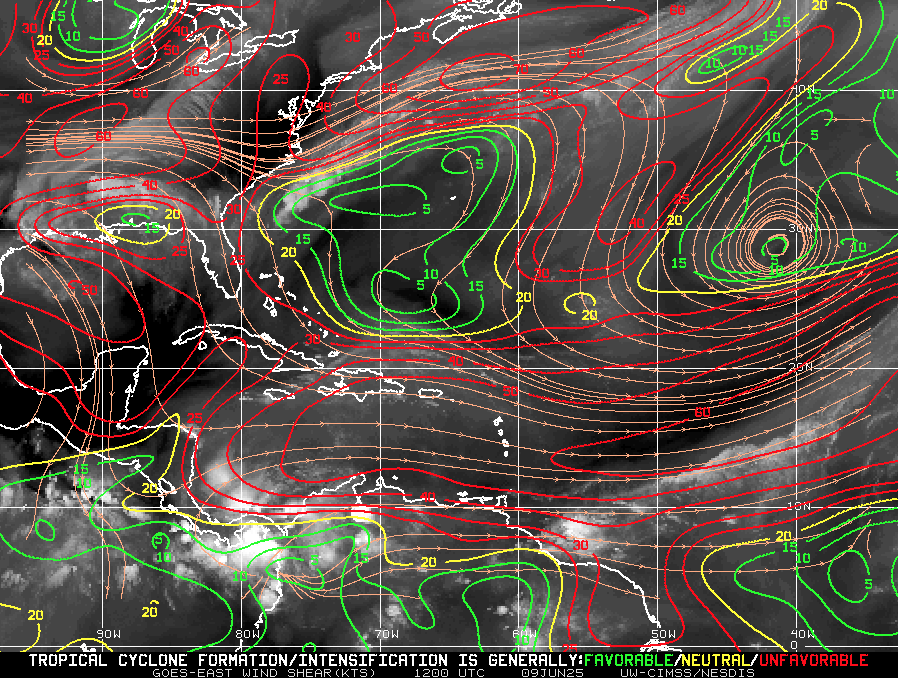Atlantic Hurricane Outlook – August 8, 2025: Dexter Is Now Post-Tropical; Invest 96L Gains Strength
Post-Tropical Cyclone Dexter exits the Atlantic, while Invest 96L shows increasing potential for tropical development. Conditions remain favorable with record-warm waters and weakening Saharan dust.
Post-Tropical Cyclone Dexter is moving off into the North Atlantic, fully transitioning into an extratropical system. Meanwhile, tropical wave Invest 96L in the central Atlantic now has a high chance of development, and another system further east offers mid-range development potential.
Atlantic Basin Overview
Dexter has become an expanded, post-tropical storm centered near 41.4° N, 50.4° W
—convection is waning and structure is elongated. (NHC advisory)Invest 96L (tropical wave near ~38° W):
Development chances now stand at 60% within 7 days. Recent observations show disorganized showers, but environmental trends suggest improved potential.New wave along ~38° W with an embedded 1011 mb low around 17° N:
Minimal convection currently, but models indicate conditions may become more favorable later this weekend.
—Chance of development: Low in 48 hours, medium in 7 days.
Environmental Conditions
Sea Surface Temperatures (SSTs): Remain strongly elevated—2–4 °F above average, with localized hotspots reaching 90 °F—offering ample fuel for future storm growth.
Wind Shear: Still moderate to high in the central tropical Atlantic; however, models suggest gradual easing may occur later in the month.
Saharan Air Layer (SAL): Though dust continues to suppress early-season convection, its influence is weakening, particularly in the western basin.
Dust & SAL data from Windy.com
Gulf & Caribbean Update
No tropical activity present.
A high-pressure ridge maintains calm, dry conditions across both regions, with only typical late-summer showers in coastal zones.
GOES-19 - Sector view: Gulf of America
GOES-19 - Sector view: Caribbean
Florida Forecast
Highs: Near 90 °F, with sticky, humid air.
Rain: 40–50% chance of afternoon thunderstorms driven by sea breezes.
Winds: Light and variable; no tropical weather expected.
Rain forecast visualization courtesy of Windy.com
Prep Tip of the Day
With Invest 96L showing increasing organization potential, now is an excellent time to check:
Hurricane supply kits
Evacuation plans
Emergency alert systems across your household
TL;DR – August 8 Snapshot
Dexter has become post-tropical—no land threat.
Invest 96L: 60% chance of development over the next week.
Another eastern wave: Low immediate risk, medium chance in 7 days.
SSTs warm, SAL draining, shear easing—conditions veering toward more activity.
Stay tuned—peak season is ramping up quickly.
For daily updates, stay locked to Cat5Prep.com.
Atlantic Hurricane Outlook – July 31, 2025: Tropics Active But No Storms on the Horizon
Tropical waves continue to move across the Atlantic, but none show signs of organization. Saharan dust and wind shear are keeping storm development in check—for now.
*Those who like data, continue reading. Those it prefer the quick version, jump to the TL;DR here.
The Atlantic basin continues to host several tropical waves—but none are expected to organize into tropical cyclones over the next seven days. Despite warm seas and increasing moisture, wind shear and Saharan dry air maintain a suppressive environment.
Atlantic Basin Summary
As of the 8:00 AM EDT Tropical Weather Outlook (TWO) from the National Hurricane Center, there are:
No active tropical cyclones.
No areas under investigation for development in the next 48 hours or seven days.
The Tropical Weather Discussion (issued at ~12:15 UTC) reveals:
A tropical wave near 43°W (south of 22°N) moving westward at 10–15 kt, with scattered moderate convection between 4–10°N.
Another wave near 55°W (south of 18°N) moving west at about 10 kt, with minimal convection.
These waves are being monitored but show no organized structure or circulation at present.
Key Weather Factors
Sea Surface Temperatures (SSTs):
Across the Gulf of Mexico, Caribbean, and MDR, SSTs range from 29–31 °C (84–88 °F)—values supportive of tropical development if atmospheric conditions improve.
Wind Shear:
Remains moderate to high across most of the Atlantic basin, limiting vertical development of disturbances.
Saharan Air Layer (SAL):
Dry and dusty air persists across the central and eastern Atlantic, suppressing convection in the MDR.
Atmospheric Moisture:
While moisture is gradually increasing near the Caribbean and western tropical Atlantic, the dry air and shear continue to hinder system organization.
Gulf of America (Mexico) & Caribbean Region
No low-pressure areas or disturbances are being tracked.
A dominating high-pressure ridge supports generally light winds and calm seas across the Gulf and Caribbean.
Offshore rainfall remains typical for this time of year—no tropical impacts on the Florida peninsula.
GOES-19 - Sector view: Gulf of America - Sandwich
GOES-19 - Sector view: Caribbean - Sandwich
Florida Forecast
High temperatures: Near 90 °F under humid conditions.
Afternoon showers and thunderstorms: 40–50% likelihood due to sea breeze convergence.
Winds: Light and variable inland; east-southeasterly along the coast.
Precipitation: Not driven by tropical systems.
Rain forecast visualization courtesy of Windy.com
Preparation Tip: Review Your Evacuation Plan
Take advantage of the lull to finalize your hurricane readiness:
Verify evacuation zones and travel routes.
Confirm alert registration with local and state emergency systems.
Update contact information and checklist locations with household members.
Outlook & Future Signal
Although today’s conditions remain tranquil, the ongoing wave train emerging from Africa and gradually improving moisture and SST profiles suggest that rainfall and organization potential may increase in early August.
TL;DR – July 31, 2025 Snapshot
No tropical systems present.
Two tropical waves travel west, but show none of the structure needed for development.
Strong wind shear and Saharan dust continue to suppress storm formation.
Warm waters and increased moisture hint at higher activity potential in August.
Stay informed and prepare while the pace allows. Daily updates continue at Cat5Prep.com.
Atlantic Hurricane Outlook – July 16, 2025: Gulf Disturbance Lingers, Tropics Stay Quiet
A weak low in the Gulf of Mexico brings rain and storms to Florida, but no tropical development is expected. Cat5Prep’s daily update covers real-time conditions, SSTs, and what to watch next.
The Atlantic hurricane basin remains quiet in terms of named storms, but attention continues to center on a weak low-pressure system lingering over the eastern Gulf of Mexico. Although this system remains disorganized and development chances are low, it’s bringing widespread showers and thunderstorms across parts of Florida, the northeastern Gulf, and coastal Georgia.
While no tropical development is expected over the next 7 days, the broader environment is slowly shifting toward favorability, with rising sea surface temperatures, weakening wind shear, and the gradual retreat of the Saharan Air Layer (SAL).
Atlantic Basin Overview
As of the latest NHC update (2:00 PM EDT):
No active tropical cyclones
One disturbance in the Gulf of Mexico (Low development chance)
No tropical formation expected in the next 7 days
Satellite imagery courtesy of Windy.com
Disturbance in the Gulf of Mexico
A broad area of low pressure continues to meander just west of Florida over the northeastern Gulf of Mexico:
Development chances remain low (0% over 48 hours, 10% over 7 days)
System remains non-tropical and disorganized
Producing periods of heavy rainfall, especially across the Florida Panhandle, southern Georgia, and coastal South Carolina
Some gusty winds and isolated flooding may occur, especially in areas with poor drainage
This system is expected to drift inland by late Thursday, reducing any tropical potential.
Radar imagery courtesy of Windy.com
Sea Surface Temperatures (SSTs)
Ocean temperatures remain exceptionally warm, providing high potential energy for storm development once other conditions align:
Gulf of Mexico: 86–89°F (2–4°F above normal)
Western Caribbean: 85–88°F
Main Development Region (MDR): Now reaching 82–84°F across much of the eastern Atlantic
Sea Surface Temperature data courtesy of Windy.com
Atmospheric Conditions
Wind Shear Courtesy of https://tropic.ssec.wisc.edu/
Wind Shear: Still elevated in the western Atlantic and Gulf, but beginning to weaken, particularly near Central America and the western Caribbean.
Moisture: Mid-level moisture continues to increase, especially in the Caribbean and southern Gulf.
Saharan Air Layer: A large, dry SAL continues to stretch across the central Atlantic, suppressing storm formation east of the Lesser Antilles, but it's expected to weaken by early August.
Relative Humidity (ECMWF) data courtesy of Windy.com
Saharan Air Layer (Dust) data courtesy of Windy.com
Thunderstorm & Rainfall Activity
Florida & Gulf Coast: Expect locally heavy rain and thunderstorm clusters tied to the Gulf disturbance.
Western Caribbean: Some disorganized convection continues, but nothing tropical at this time.
West Africa: A new tropical wave has emerged, but faces significant dry air and shear over the central Atlantic.
Rainfall forecast (ECMWF) courtesy of Windy.com
Florida Forecast
Highs: Upper 80s to low 90s°F
Humidity: High, with a heat index reaching the upper 90s
Rain: 60–70% chance of scattered storms in parts of Florida, especially in the afternoon and evening
Winds: Light southeast winds, with occasional gusts during storms
Prep Tip of the Day: Review Flood Insurance Coverage
Standard homeowners insurance does not cover flood damage. Use this calm window to:
Check your flood zone designation
Review your current policy limits
Confirm your coverage start date (flood insurance usually has a 30-day waiting period)
With warm SSTs and an increasingly favorable atmosphere, inland and coastal flood risk rises as we move deeper into hurricane season.
Looking Ahead: Watchful, Not Worrying
Although July 16 brings no immediate storm threats, all eyes remain on the broader Atlantic:
The ingredients for development are aligning: warm water, weakening shear, and increased moisture.
The next two weeks may see the first organized systems forming in the western Caribbean or Gulf of Mexico.
Now is the time to stay informed and finalize preparations—not when a storm is already on the map.
Atlantic Hurricane Outlook – July 13, 2025: Tropics Quiet, Gulf Trough Under Watch
No named storms today, but a low-pressure trough drifting toward the Gulf of Mexico could bring rain and potential tropical development later this week.
The Atlantic basin remains calm today, with no active named storms. However, meteorologists are tracking a low-pressure trough emerging off the Southeast U.S. coast, gradually drifting into the Gulf of Mexico. This system has a low (20%) chance of organizing into a subtropical or tropical system later this week .
Atlantic Overview: Quiet But Evolving
As per the 8 AM EDT NHC Tropical Weather Outlook:
No active tropical cyclones across the basin.
The Southeast U.S. trough is expected to push into the Gulf by Tuesday.
Formation chances: <1% in next 48 hours, ~20% over 7 days .
Though not tropical now, its movement may increase rainfall and raise attention if organization begins.
Satellite view via Windy.com
Sea Surface Temperatures: A Warm Platform
The Gulf of Mexico continues to show SSTs 2–4°F above average, providing a warm environment for storm development later this season.
Caribbean and Main Development Region (MDR) SSTs also remain elevated, keeping hurricane fuel accessible .
Sea Surface Temperature via Windy.com
Atmospheric Setup: Suppression in Play
Wind Shear Courtesy of https://tropic.ssec.wisc.edu/
Wind shear remains moderately strong across much of the basin, hindering storm development.
Saharan dust is still prevailing over the eastern Atlantic, suppressing early-season storm growth.
Moisture levels are slowly increasing in the Gulf and Southeast U.S., signaling gradual support for convection.
Saharan Air Layer (Dust) via Windy.com
Regional Weather: Rain on the Rise
Expect increased showers and thunderstorms along the Southeast U.S. and Gulf coasts as the trough approaches.
Florida will likely see scattered afternoon storms, typical for July, especially as the trough draws moisture inland.
Thunderstorm Forecast (ECMWF) via Windy.com
Prep Tip of the Day: Be Rainwise
Even without strong winds, heavy rainfall can pose serious hazards:
Track the trough’s movement—it could bring localized flash flooding to Gulf coast areas.
Ensure storm drains and sump pumps are clear and functional.
Keep sandbags and quick barriers ready if you're in low-lying zones.
Test your NOAA Weather Radio and mobile alerts to stay ahead of rainfall warnings.
Looking Ahead: Waters Stay Warm—Storms Could Spark
Although the tropics are peaceful now, the combination of warm ocean temperatures, easing atmospheric inhibitors, and growing seasonal moisture suggest readiness for evolution. The trough may serve as the first spark of Gulf activity, with a watchful eye needed through mid- to late-week.
Stay alert and check back tomorrow for your latest update from Cat5Prep.com.
Atlantic Hurricane Outlook – June 18, 2025: Tropics Stay Quiet as Pacific Storms Steer Focus
The Atlantic remains storm-free on June 18, with no tropical systems expected over the next 7 days. But warming ocean temps and an active Pacific raise long-range concerns.
The Atlantic basin remains calm today, with no active tropical cyclones and no systems being monitored for development in the National Hurricane Center’s latest 2 AM EDT outlook. This early-season quiet continues, but shifting global patterns—warm oceans, dust, and Pacific activity—are fueling a cautious watchfulness.
Atlantic Basin: Clear, But Keep Watching
No Atlantic systems are active, and the seven-day forecast shows no tropical development expected this week . While mid-June calm is common, meteorologists note stronger global volatility due to cross-basin interactions and shifting climate signals.
Satellite view via Windy.com
Pacific Spotlight: Tropical Storm Erick on the Rise
Wind Speed Probability Tropical Storm Erick
All eyes are on the Eastern Pacific, where Tropical Storm Erick is rapidly strengthening—forecast to become the season’s first Pacific hurricane. Though Erick poses no threat to U.S. shores, it demonstrates the early-season dynamism that Atlantic may encounter soon.
Wind Gust Accumulation Forecast (ECMWF) via Windy.com
Sea Surface Temperatures: Heat Builds Beneath the Calm
Gulf & Western Caribbean: SSTs remain well above average (84–88 °F), providing potential fuel.
Main Development Region (MDR): Water temperatures are warming and trending warmer than early June norms, laying a foundation for development later in the season.
Sea Surface Temperature via Windy.com
Saharan Dust & Atmospheric Inhibitors
Wind Shear Courtesy of https://tropic.ssec.wisc.edu/
A large plume of Saharan dust continues to stretch across the Atlantic and into the Caribbean and Southeast U.S., suppressing tropical formation and degrading air quality.
This dust layer, combined with moderate wind shear, continues to inhibit tropical systems.
Saharan Air Layer (Dust) via Windy.com
Thunderstorm Activity: Summer Rhythm
Florida & Southeast U.S.: Expect standard afternoon thunderstorms, born from daytime heating—not tropical phenomena.
Caribbean & Atlantic: Skies remain clear, with no clusters or organic storms forming.
Air Quality Alert: Sensitive groups should note haze and dust over the Southeast.
Thunderstorm Forecast (ECMWF) via Windy.com
Florida Forecast (June 18)
Highs: Upper 80s to low 90s°F (31–33 °C)
Humidity: High, with muggy conditions
Rain: Isolated to scattered afternoon storms
Visibility: Reduced by dust haze in some regions
Winds: Light, stronger near storms
Rainfall Forecast (ECMWF) via Windy.com
Prep Tip of the Day: Monitor Dust and Air Quality
Minimize outdoor exposure if you’re sensitive to dust
Clean or replace filters in HVAC systems
Keep monitoring dust levels through local air-quality alerts
Continue hurricane planning while skies are calm
Looking Ahead: Still Quiet, But Global Trends Are Stirring
No Atlantic storms are expected this week. However:
SSTs remain elevated
Wind shear may ease gradually
Saharan dust may shift or thin
Eastern Pacific activity—like Erick—offers insight into potential future Atlantic behavior
Use this calm period to prepare. Tomorrow could bring the first tropical ripple, so stay connected to Cat5Prep for ongoing updates.
Atlantic Hurricane Outlook – June 11, 2025: Quiet Tropics Continue Amid Rising Possibilities
he Atlantic basin remains calm on June 11, 2025, with no tropical storms or disturbances expected over the next week. However, warming sea surface temperatures and easing atmospheric barriers hint at increased hurricane activity later this month. Stay prepared with daily updates from Cat5Prep.com.
The twelfth day of the 2025 Atlantic hurricane season opens with calm conditions—no tropical storms, depressions, or areas being actively monitored. According to the National Hurricane Center (NHC), no tropical cyclone formation is expected over the next seven days. The basin remains in an early-season lull, but the combined presence of warm water and easing atmospheric barriers demands continued attention.
Atlantic Basin: Clear Today, But Shifts Are Underway
Active Systems: Zero
Disturbances: None
Tropical Formation Outlook: No development expected through June 18, 2025.
This state of inactivity is consistent with early June climatology. Still, meteorologists point out that subtle environmental shifts are in motion beneath the surface.
Satellite imagery courtesy of Windy.com
Sea Surface Temperatures: A Growing Foundation
Gulf of America (Mexico) & Western Caribbean: Steady low- to mid‑80s °F (27–29 °C), ideal for fuel if storms form
Main Development Region (MDR): Sea surface temperatures are trending above normal for early June
These warm waters persist as a critical energy reserve for potential fast-moving tropical systems.
Sea surface temperature data courtesy of Windy.com
Wind Shear & Moisture: Gradual Improvements
Wind Shear: Moderate to high across much of the basin, suppressing storm development
Moisture: Midlevel humidity is slowly climbing in the Gulf and Caribbean—supporting the formation of deeper convection
This evolving balance suggests the atmosphere may be priming for tropical cyclones in the coming weeks.
Wind Shear Courtesy of https://tropic.ssec.wisc.edu/
Saharan Air Layer: A Continuing Deterrent
An active plume of Saharan dust covers the central and eastern Atlantic, suppressing convection and reinforcing vertical wind shear
This protective layer is expected to weaken by late June, enabling better conditions for tropical wave development
Saharan Air Layer (SAL) data courtesy of Windy.com
Thunderstorm Activity: Local, Non-Tropical
Florida & Southeast U.S.: Expect isolated afternoon storms—standard for this time of year
Western Caribbean: A few clusters of showers persist but remain disorganized
Central Atlantic: Remains convection-free with no signs of tropical wave development
Thunderstorm data courtesy of Windy.com
Florida Forecast (Statewide)
Highs: Upper 80s to low 90s °F (31–33 °C)
Humidity: Moderate to high—classic muggy summer conditions
Rain: Scattered midday and afternoon thunderstorms
Winds: Light and steady
Rainfall data courtesy of Windy.com
Prep Tip of the Day: Check NOAA Weather Radio
Take advantage of quiet skies to:
Test your NOAA Weather Radio
Confirm you are signed up for mobile and text alert services
Ensure your emergency gear is functional and accessible
Staying alert now reduces stress later.
Looking Ahead: Remain Alert, Not Alarmed
While no tropical formations are expected through June 18, the convergence of:
Persisting warm SSTs
Weakening wind shear
And waning Saharan dust
set the stage for increased activity during the latter half of June.
Stay connected to Cat5Prep.com for your daily update and tracking as the tropical season progresses.
Atlantic Hurricane Outlook – June 10, 2025: Quiet Continues, But Observers Stay Alert
No storms in sight, but sea surface temperatures continue to rise and wind shear is gradually easing—signs that the quiet start to the 2025 hurricane season may not last.
The tenth day of the 2025 Atlantic hurricane season opens with calm skies and no immediate threats. The latest update from the National Hurricane Center (NHC) confirms no active systems and no expected tropical cyclone formation over the next seven days. Early June often starts this way, but with sea surface temperatures climbing and atmospheric factors slowly shifting, vigilance remains important.
Atlantic Basin: No Systems in Sight
No active tropical cyclones
No areas of interest
No development anticipated within 7 days
This outlook aligns with the expected early-season lull, but conditions are steadily changing.
Satellite data courtesy of Windy.com
Sea Surface Temperatures: Warming Trend Continues
Gulf of Mexico & Western Caribbean: Still in the low to mid‑80s °F (around 27–29 °C), ideal for fueling storms when other factors permit
Main Development Region (MDR): Running warmer than average for early June—enough to support development later this month
These warm waters are critical as the season progresses.
Sea Surface Temperature data courtesy of Windy.com
Atmospheric Conditions: Mixed Signals
Wind Shear: Moderate to high across much of the basin, particularly within the western Caribbean and central Atlantic—limiting today’s storm potential
Moisture: Mid-level moisture appears to be on the rise, which could support future thunderstorm activity
Wind Shear Courtesy of https://tropic.ssec.wisc.edu/
Saharan Air Layer: A Dry Deterrent
A robust plume of Saharan dust continues to suppress tropical wave development across the eastern Atlantic and MDR
This dry layer is expected to ease by late June, removing one of the key early-season inhibitors
Saharan Air Layer data courtesy of Windy.com
Thunderstorm Activity: Routine, Not Tropical
Florida & Southeastern U.S.: Expect isolated afternoon storms typical for June
Western Caribbean: A few disorganized showers and storms—no rotation or organization evident
Atlantic Ocean: Quiet, with no tropical wave activity currently observed
Thunderstorm data courtesy of Windy.com
Florida Forecast (Statewide)
Highs: Upper 80s to low 90s °F (31–33 °C)
Humidity: Moderate to high—classic muggy comfort
Rain: Scattered afternoon/evening showers typical of early summer
Winds: Light and variable
Rain data courtesy of Windy.com
Prep Tip of the Day: Check Evacuation Zones
With time on your side:
Confirm your evacuation zone and review the planned evacuation route
Update your family emergency contact lists
Ensure your NOAA weather radio and mobile alert settings are active
Keep local emergency management contacts accessible
Looking Ahead: Still Quiet, But Watch for Change
While no tropical development is expected this week, underlying conditions are subtly shifting:
Warm ocean waters persist
Atmospheric wind shear is forecast to gradually decrease
Moisture levels are on the rise
Saharan dust is weakening, removing suppression barriers
Early hurricane season often starts quietly—but conditions can change fast. Stay tuned to Cat5Prep.com for daily updates.
Atlantic Hurricane Outlook – June 9, 2025: Tropical Tranquility Continues
No storms are expected this week as the Atlantic hurricane season stays quiet. Warm waters and shifting wind patterns suggest activity could increase later in June. Stay prepared with today’s full update.
The ninth day of the 2025 Atlantic hurricane season dawns with quiet conditions—no active storms or signs of tropical development are present. The National Hurricane Center (NHC) confirms that no tropical cyclone formation is expected in the Atlantic Basin over the next seven days. It's a typical early-June lull, but with warming waters and shifting atmospheric dynamics, conditions may change quickly.
Atlantic Basin: Clear Skies, No Areas of Concern
No active tropical cyclones
No disturbances or systems being monitored
7-day outlook shows no development expected
This continued calm aligns with seasonal norms—but forecasters are keeping a cautious eye on the evolving environment.
Satellite imagery courtesy of Windy.com
Sea Surface Temperatures: Warm and Watchful
Gulf of America (Mexico) & Western Caribbean: Sea surface temperatures remain in the low‑to‑mid‑80s °F (27–29 °C), sufficient to fuel tropical systems.
Main Development Region (MDR): SSTs are gradually rising, though not yet at peak summer levels.
These ongoing warm waters provide a key energy source for future storm formation.
Sea Surface Temperature (SST) data courtesy of Windy.com
Atmospheric Conditions: Still Mixed, Not Conducive
Wind Shear: Moderate to high shear persists, particularly in western Caribbean and central Atlantic—suppressing thunderstorm organization.
Moisture Levels: While mid-level atmospheric moisture is increasing, it's not yet sufficiently abundant or widespread to support cyclone development.
Together, these factors continue to limit tropical activity.
Wind Shear Courtesy of https://tropic.ssec.wisc.edu/
Saharan Air Layer: A Persistent Block
A strong plume of dry, dusty Saharan air remains entrenched over the central and eastern Atlantic.
This Saharan Air Layer (SAL) injects dryness and wind shear that further inhibit storm formation.
Expect suppression to continue into mid-June when SAL influence typically begins to decline fox35orlando.com.
Saharan Air Layer (Dust) data courtesy of Windy.com
Thunderstorm Activity: Routine, Non-Tropical
Florida & Southeast U.S.: Scattered afternoon storms—typical for early June.
Western Caribbean: A few isolated, disorganized cells persist, but show no signs of development.
Eastern Atlantic: Quiet and without organized convection.
These systems are seasonal and not related to hurricane development.
Thunderstorm data courtesy of Windy.com
Florida Forecast (All Regions)
Highs: Upper 80s to low 90s °F (31–33 °C)
Humidity: Moderate to high, creating a muggy atmosphere
Rain: Isolated to scattered afternoon and evening storms
Winds: Light and variable
A classic early-summer day with palm trees swaying but no storm threats.
Rainfall forecast courtesy of Windy.com
Prep Tip of the Day: Review Evacuation Plans
Use this calm window to double-check your evacuation readiness:
Reconfirm your evacuation zone and route.
Update your household emergency plan, including pets and special needs.
Keep contact numbers accessible, especially local officials and emergency services.
Test your NOAA weather radio and ensure alerts are activated on mobile devices.
Looking Ahead: Still Calm, But Eyes Remain Open
No tropical development is forecast this week, but the environment is slowly warming and becoming more favorable:
Warm water concentrations persist
Wind shear may decrease in the coming weeks
Moisture levels are increasing regionally
While it's still quiet, conditions are edging toward potential activity. Continue to check in daily for updates as Cat5Prep.com monitors the evolving season.
Atlantic Hurricane Outlook – June 6, 2025: Quiet Tropics, No Development Expected
June 6, 2025: No named storms or tropical threats in the Atlantic basin today, but signs of change are emerging. Sea surface temperatures continue to climb, and wind shear may weaken in the coming weeks. Now’s the time to review your hurricane prep plan.
The 2025 Atlantic hurricane season continues with a calm week, as no tropical cyclones or areas of concern are present. The National Hurricane Center (NHC) confirms no tropical development is expected over the next seven days, marking a quiet yet cautious start to June.
Atlantic Basin: Clear Skies for Now
From the 8 AM EDT Tropical Weather Outlook issued June 6:
No active tropical cyclones
No areas of concern
No development expected in the next seven days
The NHC’s maps and guidance reflect this assessment, indicating a continued quiet period. Notably, previous offshore coastal disturbances have been dropped and are no longer being tracked.
Satellite imagery courtesy of Windy.com
Sea Surface Temperatures: Stable But Still Warm
Warm SSTs persist in regions key to hurricane development:
Gulf of America (Mexico) & Western Caribbean: Remain seasonally warm (low to mid-80s°F)
Main Development Region (MDR): Still trending above normal for early June
While SSTs provide essential fuel, other atmospheric factors currently suppress development.
Sea surface temperature data courtesy of Windy.com
Wind Shear & Moisture: Conditions Not Yet Favorable
Wind Shear: Moderate across much of the basin, particularly in the western Caribbean and central Atlantic
Atmospheric Moisture: Rising gradually, but not yet supportive of storm formation
These conditions reduce the likelihood of tropical development in the immediate future.
Wind Shear Courtesy of https://tropic.ssec.wisc.edu/
Saharan Air Layer: Suppression in Full Effect
A strong plume of Saharan dust continues to suppress Atlantic convection:
Dry air and elevated shear persist across the eastern tropical Atlantic and MDR apnews.com
The SAL remains a key barrier to any early-season system development
Expect this barrier to weaken later in June
Saharan Air Layer (SAL) dust data courtesy of Windy.com
Thunderstorm Activity: Localized, Non-Tropical
Florida & Southeastern U.S.: Scattered afternoon thunderstorms—normal for this season
Western Caribbean: Isolated, disorganized showers and storms with no rotation
Eastern U.S. Coast: No significant organized convection detected
These are routine summer thunderstorms—not tropical systems.
Thunderstorm forecast data courtesy of Windy.com
Florida Forecast: Typical Early Summer Conditions
Expect another classic June day:
Highs: Upper 80s to low 90s°F (31–33 °C)
Humidity: Moderate to high, creating muggy conditions
Rain: Scattered afternoon and evening showers likely
Winds: Light and variable
Rainfall forecast data courtesy of Windy.com
Prep Tip of the Day: Emergency Alerts and Insurance
Take advantage of today’s calm to:
Confirm your emergency alert subscriptions, including text and email
Review your insurance coverage and update policy details if needed
Gather digital and physical copies of critical documents
Familiarize yourself with evacuation zones in your area
Looking Ahead: Still Calm, But Stay Vigilant
NHC projections show no tropical development through June 13–14, but underlying conditions—particularly warm waters and gradually weakening shear—will become increasingly favorable. The primary barriers are the Saharan dust layer and fluctuating atmospheric moisture.
Remember: hurricanes can form quickly when conditions align. Continue to monitor daily forecasts at Cat5Prep.com.

